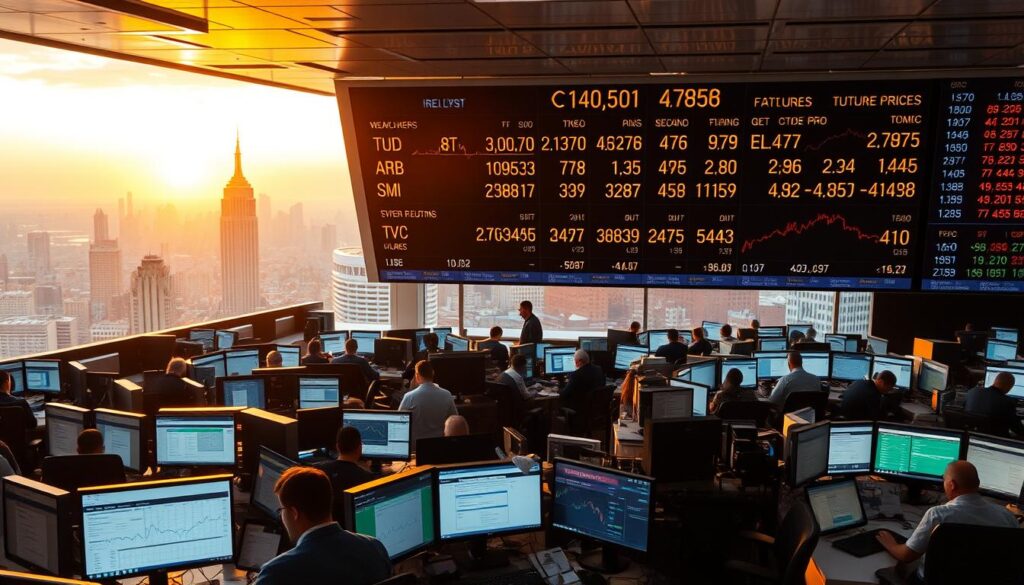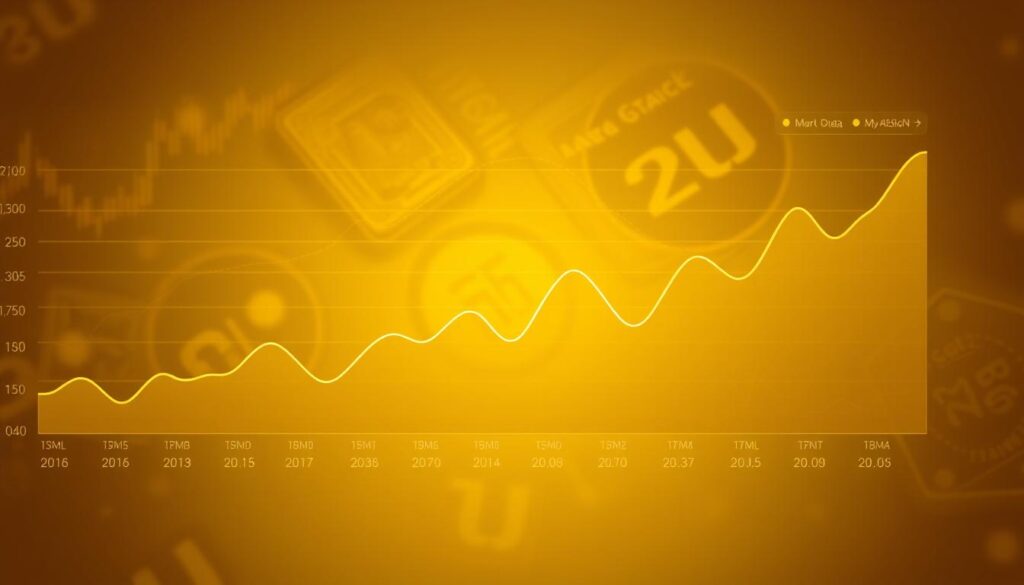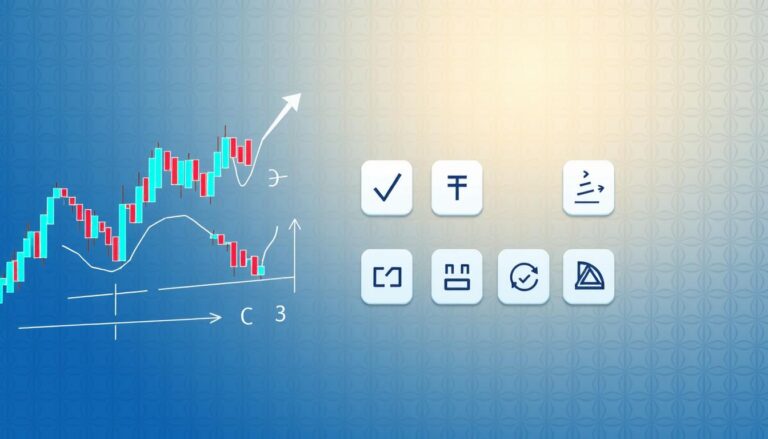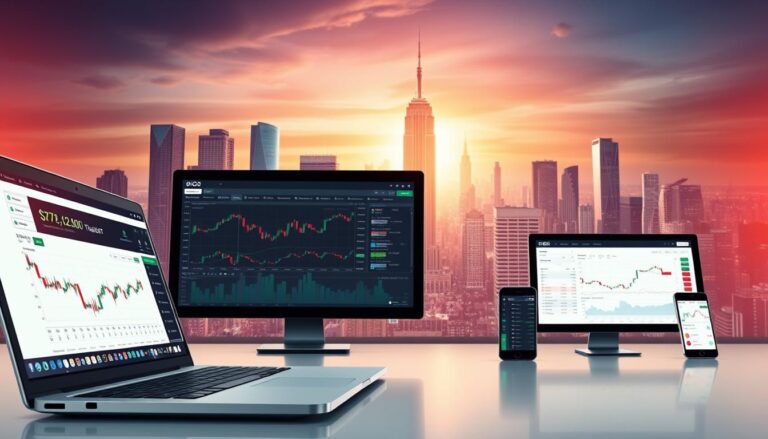Gold Futures Explained: Markets, Trends, and Analysis
Commodity derivatives tied to precious metals offer a fast-paced environment for investors. These financial tools combine high potential rewards with substantial risks, requiring careful strategy and awareness of global economic shifts. Price swings often reflect geopolitical events, currency fluctuations, and macroeconomic data.
Participants can engage with standardized contracts through regulated exchanges without handling physical assets. This approach creates leverage opportunities, amplifying outcomes in both directions. Margin requirements significantly impact exposure, making risk management vital for long-term success.
The marketplace operates as a complex network where contracts follow strict settlement rules. Traders analyze historical patterns and real-time information to anticipate movements. External factors like central bank policies or inflation reports frequently drive short-term volatility.
Understanding contract specifications and expiration cycles proves critical for effective participation. Settlement methods—whether cash or delivery—affect strategy choices. Seasonal demand shifts and mining sector developments also play roles in shaping prices.
This guide breaks down essential concepts, from basic mechanics to advanced tactics. It explores how interest rates, geopolitical tensions, and industrial demand intersect in this arena. Readers will gain actionable insights to navigate this sophisticated financial landscape responsibly.
Understanding Gold Futures Markets
Standardized agreements form the backbone of modern commodity trading. These financial instruments allow participants to lock in prices for assets months ahead, balancing risk and opportunity. Major exchanges ensure uniformity across deals, removing guesswork from contract details.
What Are Futures Contracts?
A futures contract binds two parties to trade a set asset quantity at a fixed price on a future date. Unlike spot trading, no immediate payment or delivery occurs. This delay lets traders speculate on price swings or hedge against market shifts.
Key Terminology and Market Concepts
Participants use specific terms to navigate this arena. Long positions involve buying contracts expecting price rises, while short positions mean selling anticipating drops. Exchanges enforce quality standards and settlement dates, creating fairness across transactions.
Two main groups dominate activity. Commercial users protect against unfavorable price moves in their operations. Speculators aim for profits without handling physical assets, often closing deals before settlement day. Margin requirements and leverage ratios dictate trading capacity, influencing strategy choices.
The Mechanics Behind Gold Futures Settlement

When contracts near their expiration dates, a structured process ensures obligations are fulfilled. This phase determines whether traders receive physical assets or cash equivalents based on their agreements. Exchanges enforce strict timelines to maintain market integrity.
Overview of Settlement Processes
Two primary methods govern how positions conclude. Physical delivery involves transferring certified bullion between approved depositories and buyers. However, this requires specialized logistics that most individual traders avoid. Instead, over 95% close contracts early to bypass storage and handling complexities.
Cash settlement simplifies the process by calculating price differences. Traders settle gains or losses without moving physical metal. This approach dominates markets due to its efficiency, especially among retail participants.
Exchanges halt trading days before expiration to finalize commitments. During this window, clearinghouses verify funds and inventory. Only institutions with certified storage facilities typically proceed to delivery. Others exit positions to avoid penalties or operational hurdles.
Key standards ensure reliability:
- Bullion must meet purity thresholds (e.g., 99.5% for approved bars)
- Depositories provide audited weight certifications
- Clearing members guarantee payment obligations
Understanding these mechanics helps traders anticipate deadlines and costs. Whether opting for cash resolution or physical transfer, timing decisions around settlement dates remains critical.
Margin Requirements and Trading Leverage

Trading platforms demand financial safeguards to maintain market stability. Margin acts as a security deposit, ensuring both parties honor their contractual obligations. This upfront payment reduces default risks while enabling access to larger positions.
The Role of Margin in Gold Trading
Initial margin typically represents 2%–20% of a contract’s total value. Exchanges adjust these rates based on volatility, acting as a buffer against sudden price swings. For example, a £100,000 position might require £5,000 upfront with a 5% margin.
Maintenance rules trigger alerts when account equity dips below set thresholds. Traders must then add funds or face automatic position closures. These mechanisms prevent catastrophic losses but require constant monitoring during turbulent markets.
How Leverage Can Amplify Gains and Losses
Leverage multiplies exposure using borrowed capital. A £5,000 investment could control £100,000 worth of metal contracts. While a 10% price jump yields £10,000 profit, the same drop erases the entire stake plus more.
This magnification effect demands disciplined risk management. Unlike physical ownership, leveraged positions expose traders to losses exceeding initial deposits. Strategic stop-loss orders and position sizing become non-negotiable safeguards.
Market Data: Price Movements, Trends, and Analysis

Real-time numbers drive decisions in commodity markets. Traders scrutinise patterns to predict where values might head next. Spot and forward prices often diverge due to factors like interest rates and storage expenses.
Interpreting Price Gold and Spot Prices
The spot price reflects immediate transaction costs for physical metal. It serves as the foundation for all related financial instruments. Forward contracts typically trade higher or lower based on carrying costs like financing fees and insurance.
Market data reveals predictable gaps between these figures. For example, if interest rates rise, forward prices often climb to account for lost earnings on cash reserves. Storage fees further widen this spread over time.
Key factors influencing price moves include:
- Central bank policy shifts affecting currency values
- Industrial demand spikes during manufacturing booms
- Geopolitical tensions altering investor risk appetite
Technical tools like moving averages help identify trends in volatile conditions. Volume indicators show whether price changes have broad market support. Combining these methods improves timing for entries and exits.
Successful analysis balances mathematical models with real-world events. While formulas explain baseline price gaps, unexpected news can override calculated expectations. Staying updated on macroeconomic reports becomes essential for accurate forecasts.
Effective gold futures Trading Strategies

Market participants choose between two primary approaches when engaging with commodity contracts. Each method serves distinct goals, from profit-seeking to risk mitigation. Understanding these frameworks helps traders align actions with financial objectives.
Speculation Versus Hedging Approaches
Speculators aim to profit from short-term price swings without handling physical assets. They open and close positions rapidly, capitalizing on volatility. For example, a trader might buy contracts anticipating geopolitical tensions will boost demand, then sell before expiration.
Hedgers use these instruments as insurance against adverse market shifts. Jewelry manufacturers might lock in prices to stabilise production costs. This protects profit margins if values surge unexpectedly.
Four common tactics shape decision-making:
- Directional bets: Taking long or short positions based on predicted price trends
- Spread trading: Profiting from price gaps between contract months
- Arbitrage: Exploiting temporary price differences across markets
- Algorithmic systems: Using automated tools to execute high-speed trades
Risk controls remain essential. Position sizing limits exposure, while stop-loss orders automatically exit losing trades. Diversification across assets reduces reliance on single-market outcomes.
Risk Management: Stop-Losses and Market Volatility

Managing exposure requires tools that adapt to rapid price shifts. Automated systems help traders limit downside while navigating unpredictable markets. However, these safeguards come with unique challenges demanding careful implementation.
Implementing Stop-Loss Orders
Stop-loss orders close positions automatically when prices hit preset levels. Brokers offer these as guaranteed or “best effort” services. While effective in theory, sudden market moves can trigger premature exits.
Some professionals exploit these triggers by pushing prices to activate stop orders. This manipulation creates bargain opportunities for prepared traders. Investors might face multiple small losses despite avoiding catastrophic ones.
Understanding Volatility in Trading
Price swings often intensify during economic announcements or geopolitical crises. These events create gap risk, where markets open far from previous closing levels. Stop orders executed during gaps may lock in worse prices than expected.
Three strategies reduce volatility-related risks:
- Conservative position sizing to avoid overexposure
- Maintaining margin buffers above minimum requirements
- Combining stop-losses with trend analysis tools
Seasoned traders prioritise flexibility over rigid rules. Adapting to real-time conditions often yields better results than relying solely on automated safeguards.
Interest Rates, Contango, and Backwardation
Financial markets often hinge on the relationship between borrowing costs and asset yields. This dynamic shapes pricing structures for commodity contracts, where interest rates directly influence trader expectations. When cash deposit rates exceed leasing fees for physical holdings, markets enter contango—futures trade higher than spot prices.
How Financing Costs Affect Contract Values
Contango reflects the carrying costs of holding assets over time. Storage fees and financing charges push deferred prices upward. Traders face a challenge: prices must rise faster than the contango premium erodes to turn profits before contracts expire.
In backwardation, spot prices surpass futures values. This occurs when leasing returns outpace cash interest rates or supply shortages emerge. Markets signal immediate scarcity, rewarding those holding physical assets over paper contracts.
Three factors drive these conditions:
- Central bank rate decisions altering borrowing costs
- Shifts in storage availability impacting holding expenses
- Unexpected demand surges disrupting supply chains
Seasoned participants monitor rate differentials closely. A 2% gap between dollar deposits and metal leasing fees can reshape entire trading strategies. These mathematical relationships determine whether positions gain traction or struggle against time decay.
Navigating Rollover Costs and Renewal Procedures

Maintaining positions in expiring contracts demands strategic planning. Traders must actively renew agreements to avoid automatic settlement, creating recurring administrative tasks. Unlike physical holdings, these instruments don’t permit passive investment—every expiration triggers mandatory action.
Understanding Rollover and Its Financial Impact
The rollover process involves closing near-term contracts while opening identical positions in later months. This dual transaction preserves market exposure but introduces multiple costs. Brokers often promote discounted rates for this service, though hidden fees may lurk beneath surface-level offers.
Three factors erode profitability during renewal cycles:
- Bid-ask spreads: Price gaps between buying and selling contracts
- Time decay: Shifting market conditions between contract months
- Broker commissions: Repeated fees for executing dual transactions
Quarterly renewals force traders into frequent decision-making. Emotional fatigue can lead to premature exits or poorly timed entries. Physical metal ownership sidesteps this pressure, offering a hands-off alternative for long-term holders.
Extended positions spanning multiple quarters often prove costlier than bullion purchases. After three months, cumulative rollover expenses typically outweigh storage and insurance fees for physical assets. Savvy investors compare both options before committing capital.
Choosing the Right Broker and Account Setup
Selecting a reliable intermediary forms the foundation of successful commodity market participation. Traders must partner with brokers registered on regulated exchanges like CME Group. These professionals act as gatekeepers, executing orders while ensuring compliance with exchange rules.
Account approval involves strict identity checks and financial assessments. Most brokers require two business days to verify documentation and credit history. Applicants sign risk disclosures acknowledging potential losses from leveraged trading activities.
Key considerations when comparing services:
- Real-time data access for informed decisions
- Transparent fee structures for commissions and margin calls
- Educational resources explaining complex contract specifications
Regulatory oversight protects client funds through segregated accounts. Reputable firms provide detailed information about their exchange memberships and clearinghouse partnerships. Traders should prioritize platforms offering robust risk management tools alongside market analysis features.
The right broker bridges individual strategies with global exchange networks. By balancing competitive pricing with reliable execution speeds, they help navigate fast-moving markets effectively.






